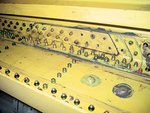- Thread starter
- #41
Photo 1: rear spar (among other items), slightly damaged bent.
Drawing (Seafire): the spars are within the red ellipses, the item marked with arrow attaches to the main spar's lower beam
Photo 2: attachment point for the rear spar should be somewhere, there...?
Photo 3: attachment point/area for the front spar - looks like it means business.
So maybe it is not a 99:1 between the load ratios of the front and rear spar; 90:10?

Drawing (Seafire): the spars are within the red ellipses, the item marked with arrow attaches to the main spar's lower beam
Photo 2: attachment point for the rear spar should be somewhere, there...?
Photo 3: attachment point/area for the front spar - looks like it means business.
So maybe it is not a 99:1 between the load ratios of the front and rear spar; 90:10?



